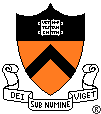

Princeton University
|
Computer Science 433
|
|
| News:
·final is online - click here for instructions. · All students taking this course should join the mailing list. · Mathematical background handout (including a "sneak preview" of exercises from Homework 1), (click here for LaTeX source) |
Cryptography or "secret writing" has been around for about 4000 years, but was revolutionized in the last few decades. The first aspect of this revolution involved placing cryptography on more solid mathematical grounds, thus transforming it from an art to a science and showing a way to break out of the "invent-break-tweak" cycle that characterized crypto throughout history. The second aspect was extending cryptography to applications far beyond simple codes, including some paradoxical impossible-looking creatures such as public key cryptography , zero knowledge proofs, and playing poker over the phone.
This course will be an introduction to modern "post-revolutionary" cryptography with an emphasis on the fundamental ideas (as opposed to an emphasis on practical implementations). Among the topics covered will be private key and public key encryption schemes (including DES/AES and RSA), digital signatures, one-way functions, pseudo-random generators, zero-knowledge proofs, and security against active attacks (e.g., chosen ciphertext (CCA) security). As time permits, we may also cover more advanced topics such as the Secure Socket Layer (SSL/TLS) protocol and the attacks on it (Goldberg and Wagner, Bleichenbacher), secret sharing, two-party and multi-party secure computation, and quantum cryptography.
The main prerequisite for this course is ability to read, write (and perhaps enjoy!) mathematical proofs. In addition, familiarity with algorithms and basic probability theory will be helpful. No programming knowledge is needed. If you're interested in the course but are not sure you have sufficient background, or you have any other questions about the course, please contact me at
Professor: Boaz Barak - 405 CS Building. Email: Phone: 609-981-4982 ?> (I prefer email)
Undergraduate Coordinator: Donna O'Leary - 410 CS Building - 258-1746 doleary@cs.princeton.edu
Teaching Assistants: Sushant Sachdeva ( sachdeva@cs ) and Shi Li ( shili@cs )
Grading: 50% homework, 50% take-home final. See syllabus for more details.
| Homework assignment | Due |
| HW1 (LaTeX source) | February 10 |
| HW2 (LaTeX source) | February 17 |
| HW3 (LaTeX source) | February 24 |
| HW4 (LaTeX source) | March 3 |
| HW5 (LaTeX source) | March 10 |
| HW6 (LaTeX source) | March 24 |
| HW7 (LaTeX source) | March 31 |
| HW8 (LaTeX source) | April 7 |
| HW9 (LaTeX source) | April 14 |
| HW10 (LaTeX source) | April 21 |
| HW11 (LaTeX source) | April 28 |
There are several lecture notes for cryptography courses on the web. In particular the notes of Trevisan, Vadhan, Bellare and Rogaway, Goldwasser and Bellare and Malkin will be useful.
Some good sources for the probability and complexity/algorithms backgrounds are:
A good source for computational number theory is A Computational Introduction to Number Theory and Algebra by Victor Shoup. Note that this book freely available on-line under the creative commons license. Another good book on this topic is A Concrete Introduction to Higher Algebra by Lindsay Childs.
Some other more application-oriented crypto books (note that these books take a much less careful approach to definitions and security proofs than we do in the course):
Alfred J. Menezes, Paul C. van Oorschot, and Scott A. Vanstone. Handbook of Applied Cryptography.
Douglas R. Stinson. Cryptography: Theory and Practice.
Bruce Schneier. Applied Cryptography.
Ross Anderson Security Engineering
February 2010
Sun Mon Tue Wed Thu Fri Sat
1 2 3 4 5 6
7 8 9 10 11 12 13
14 15 16 17 18 19 20
21 22 23 24 25 26 27
28
|
March 2010
Sun Mon Tue Wed Thu Fri Sat
1 2 3 4 5 6
7 8 9 10 11 12 13
14 15 16 17 18 19 20
21 22 23 24 25 26 27
28 29 30 31
|
April 2010
Sun Mon Tue Wed Thu Fri Sat
1 2 3
4 5 6 7 8 9 10
11 12 13 14 15 16 17
18 19 20 21 22 23 24
25 26 27 28 29 30
|